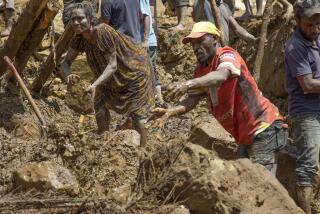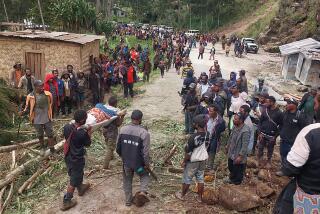COLUMN ONE : Fore! The Spears Are Incoming! : Perhaps no place has been dragged into the modern age as fast as Papua New Guinea. Alas, it’s stuck with those intractable Stone Age problems--tribal wars, spirits and sorcery.
- Share via
GOROKA, Papua New Guinea — Expatriate residents Reiner and Monica Gunther found an unmarked hazard when they grabbed their clubs and cleats and headed out for an early tee-off at the exclusive Goroka Golf Club one recent Sunday.
There, down by the misty, manicured fairway, several dozen people were facing off with real clubs. And spears. On both sides, half-naked warriors were slathered in pig grease, red clay and bright face paint. Women wore mud, carried shields and shouted furiously. It was a full-fledged tribal war.
“Suddenly they were coming down the green with bows and arrows and axes and all painted up,” recalled Monica Gunther, a Vermont-born paralegal. “The caddies had even called in sick so they could fight.”
The arrival of two gung-ho golfers temporarily stopped the battle. And, after a huddle, the caddies decided they needed their Sunday salaries. So a 24-hour truce was declared. The Gunthers played through. And the next day, the tribal war resumed.
It’s not always that way, of course. At the Minge Golf Course, cease-fires are shorter. “You’ll tee off,” explained Reiner Gunther, a German-born finance officer for a local company. “The warriors watch where the ball lands. Then they part the troops and wait. You come up, shout ‘Fore!,’ hit the ball and move on. Then they go back at it.”
Strange encounters with war and peace are par for the course in Papua New Guinea’s Highlands, one of the world’s last explored and least developed areas. It is the rich cultural core of a still mysterious, still magnificent land of tribal wars, sorcery, spirits and cults. Not to mention unusual golf.
“Probably no country’s been dragged as rapidly from the Stone Age to the modern age,” said one Western diplomat in Port Moresby, the capital. Another agreed, saying, “The fact is many people here saw a wheel for the first time on the bottom of an airplane.”
Indeed, European explorers didn’t even enter the rugged interior until 1933. They found hundreds of fierce, fiercely independent tribes hidden in towering mountains, protected by rushing rivers and impenetrable jungle. Most spoke mutually unintelligible languages and still do. The California-sized country had 854 languages at last count, one-third the world’s total.
And many tribes have a proud past. “I tell my son how long time ago, they go out, kill their enemies and eat them,” said Mai Yawa, 26, a prim, polite financial auditor who works in a Goroka office with computers, faxes and a paper shredder. “That is our history.”
It is their future that’s uncertain. Most of the 3.7 million people in the South Pacific’s largest and wildest country still live as rural subsistence farmers. But thanks to a mining and petroleum boom, the nation’s cash economy roared with 9% growth last year. The Australian banking giant, Westpac, predicts 17% growth this year. And that’s just for starters.
An alluvial gold rush atop rain-drenched Mt. Kare three years ago, for example, rivaled the Klondike: Frenzied prospectors quickly panned an estimated $300 million, sometimes plucking fist-sized nuggets from the mud.
Men with boar tusks in their noses soon showed up in shops carrying coffee mugs brimming with gold; at one point, four youths plunked down $300,000 for four Land Rovers, then called friends old enough to drive them away.
Mt. Kare closed in January after feuding claim jumpers burned a helicopter, fired shotguns and caused $2 million in damage at the site. On Bougainville Island, a violent secession movement led by landowners forced the closing of one of the world’s largest open-pit copper mines in 1989. Until then, the single mine provided almost a fifth of the nation’s income.
It’s barely missed today. Ok Tedi, a huge open-pit copper and gold mine in the remote Star Mountains, quickly made up the difference.
Then came Porgera. Opened in 1990, Porgera produced 1.2 million ounces of gold the first year, the biggest gold mine outside South Africa. Its impact is striking in villages that previously counted wealth in pigs or kina shells.
“It’s not surprising to see a guy driving one of the latest Toyotas and still wearing as gras ,” the pidgin term for leaves that cover the bare behind, said anthropologist Kuldeep Bhatia.
But Porgera will be for pikers once Lahir comes on stream. According to the government, Lahir is a virtual mountain of gold--19 million minable ounces in all, worth about $9 billion--in an extinct volcano in the New Ireland isles. Such riches are bound to affect an area previously known only for a cult that once worshiped President Lyndon Baines Johnson, supposedly because the name Johnson was on local boat engines.
Then there’s oil and gas. A consortium headed by Chevron Corp. pumped its first crude oil in June from the nation’s first oil field. The $1-billion Kutubu project has reserves of 200 million barrels and a pipeline buried 165 miles under virgin rain forest and mangrove swamps and leading to a marine terminal in the Gulf of Papua.
Plans are to pump 120,000 barrels a day by year’s end, nearly all for export. And much more exploration is under way. Millions of cubic feet of natural gas remain untapped. So do the nation’s vast forests and fisheries.
“Unlike most Third World countries, we still have a future,” said Bruce Harris, an American anthropologist who now works as a senior government planner in Port Moresby. “It’s a place with promise.”
It’s also a place with severe problems. Violence caused by conflicting land claims already has closed Bougainville and Mt. Kare. Under tribal law, there are no deeds, no surveyors, no records, no real concept of private land sales and ownership. Contracts are binding only as long as both sides agree. And conflicts will only increase as development accelerates.
“The expectations are galloping,” warned Sean Dorney, a longtime resident Australian journalist and author.
Even more serious are “rascals,” the pidgin term for rampaging gangs who specialize in gang rape and violent robberies. Diplomats are a favorite target. Last year, dusk-to-dawn curfews were imposed for six months in Port Moresby and three other towns after an Australian military adviser was shot and killed trying to protect his wife from being raped, the Philippine ambassador was mugged three times and the German ambassador was robbed and beaten.
Experts blame a breakdown in social norms: Two-thirds of the population is younger than 24, underemployed and under pressure from sudden urbanization. Many have moved to towns for jobs that don’t exist and where rural communal rules no longer apply.
“Now I have to live in my house like I’m in a state of siege,” griped Burton G. Burton-Bradley, 77, a psychiatrist whose home, like most, is behind a high fence with barbed wire. Still, gangs have broken in so often they simply smashed things last time. “The loss to me wasn’t so great because they’d already stolen everything valuable,” he said, waving his hand at nearly empty bookcases and shelves.
In Goroka, a mist-shrouded mountain town of 25,000 that is the capital of the Eastern Highlands, the rascals may be worse. Clearly the fear is.
“You can’t protect yourself,” warned Shirin Moayyad, 29, who arrived five years ago as a budding Brown University anthropologist. She soon dumped her dissertation to be plantation manager for Collins and Leahy Pty. Ltd., one of the country’s largest companies.
Today she lives in a fortress. Guards patrol beside rolls of razor wire ringing the compound. Her home is behind another fence. So are three huge dogs: Rottweiler, South African ridgeback and a pit bull, all fed hunks of raw meat.
Her bedroom door is solid steel. Window bars are welded to the house frame. A bedside button triggers a rooftop siren and flashing lights. A two-way radio, can of Mace and flare gun are in reach. A .44 magnum is under the pillow.
Moayyad quickly lists friends and tourists raped or robbed. On Chicago’s seedy South Side, where she grew up: “You can avoid it. You know where to go. You know when. The difference here is it can happen anywhere, anytime.”
No one disagrees 90 miles away in Mt. Hagen, the rowdy, Wild-West capital of Western Highlands province. Most stores are behind steel shutters and prison-thick iron bars. At dusk, the still air echoes with the clicking of padlocks--the Christian Bookshop has 32--and the clatter of people literally running off the streets by dark. Even the police barricade themselves.
“It’s not a good place to be out at night,” conceded Roy Coyle, manager of the Highlander Hotel, which offers $130-a-night rooms with satellite television as well as high walls topped with concertina wire and helmeted guards with snarling attack dogs. “Anywhere in the country really.”
And that’s a shame. The Highlands offer spectacular vistas of lush green valleys and cloud-topped purple peaks. Cicadas whir, and birds with brilliant plumage fly overhead. Wild poinsettias and dates, coffee bushes and grapefruit trees surround quiet clusters of round, thatch-roofed huts. Boys live in the boy haus , where bearded elders teach how to hunt, fish and buy a wife.
“My father paid 50 kina (now about $55), 10 pigs and black feathers,” said John Bomal, 24, taking a visitor through Tabare, a Korul clan village atop a jungled ridge an hour off the main road. Now the bride price has gone up. “They asked me for 2,000 kina. But I only paid 500.”
No one begs and no one goes hungry. In Mt. Hagen, an outdoor market offers a stunning display of fruits and vegetables: basketball-sized cabbages, ruby-red strawberries, sugar-sweet corn, huge tangerines and tomatoes. Scientists say Highlands’ agriculture dates back 10,000 years--long before Europe’s first farmers.
And democracy truly thrives. In national elections last month, the fourth since independence from Australia in 1975, an estimated 80% turnout of voters chose a new Parliament. Make that a very new Parliament--they voted out 59 of the 109 incumbents. It was no surprise: 90 members have been investigated for alleged corruption.
The new prime minister, former opposition leader Paias Wingti, campaigned mostly against corruption. Rascals were not an issue after the outgoing Parliament approved reintroducing the gallows for murder and rape. Tossed out, however, was a proposal to tattoo convicted criminals on the forehead with the name of their crime.
No matter. Many Papua New Guineans already look as if they drink blood. It’s the unnerving result of chewing Areca palm, called betel nut. Mixed with lime and pepper stalks, it stains mouths a brilliant scarlet and teeth black. One sign of the nut’s narcotic effect is that devotees consider the vampire look beautiful. Another is nonstop spitting.
Several dozen Highlanders gathered with bright red smiles under tall pines near Kanangi, for example. Many of the women and children also wore thick ocher mud from head to toe. Several sported white face paint. Soon a truck lurched by carrying 10 men covered in red mud. One man wore a fur-tailed cap, like Davy Crockett. Others wore feathers, shells or floppy hillbilly-style hats.
It was a funeral march. Or it would be once the body arrived.
“People are afraid they used sorcery to kill him,” explained Norifo Sila, a barefoot, bushy-bearded village magistrate. “So we took him to Goroka Base Hospital for a post-mortem. Now we wait.”
Sorcery is illegal, but the men were ready--just in case. Most carried bows and arrows, axes or spears.
Tribal wars are illegal, too. But no one usually minds since they are largely ritual, with more shouting than shooting. Villagers see them as a way of resolving conflicts, not aggravating them. As a result, major casualties are rare--except when firearms are used.
In December, for example, two large tribes warred after a boy was killed in a traffic accident near Kundiawa, capital of Chimbu province. The victim’s clan demanded $12,000 in compensation. The other clan declined. The resulting battle left two men dead and a dozen wounded from gunfire and arrows.
“Afterward, the police went and burned all their houses and gardens,” said Peseve Kerenga, assistant health director in Kundiawa.
To discourage tribal fights, the provincial hospital now charges $60, 10 times the normal rate, to treat gunshot, arrow or spear wounds. Still, the fights have a certain charm.
At a recent battle in downtown Goroka, arrows and spears flew behind the Bird of Paradise Hotel. Traffic stopped, and tourists and office workers huddled nervously inside. Police finally used tear gas to disperse the tribes after several arrows hit a clothesline and perforated bedsheets of the town judge.
“It was very exciting,” said Monica Gunther, proudly showing a hand-carved, sharp-barbed arrow she plucked from her office window screen. “I even got a souvenir!”
More to Read
Sign up for Essential California
The most important California stories and recommendations in your inbox every morning.
You may occasionally receive promotional content from the Los Angeles Times.











